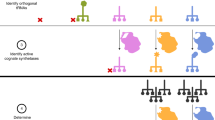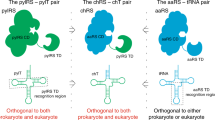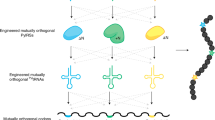Abstract
Over the course of evolution, eukaryotic aminoacyl-tRNA synthetases (aaRSs) progressively incorporated domains and motifs that have no essential connection to aminoacylation reactions. Their accretive addition to virtually all aaRSs correlates with the progressive evolution and complexity of eukaryotes. Based on recent experimental findings focused on a few of these additions and analysis of the aaRS proteome, we propose that they are markers for aaRS-associated functions beyond translation.
This is a preview of subscription content, access via your institution
Access options
Subscribe to this journal
Receive 12 print issues and online access
$189.00 per year
only $15.75 per issue
Buy this article
- Purchase on Springer Link
- Instant access to full article PDF
Prices may be subject to local taxes which are calculated during checkout



Similar content being viewed by others
References
Carter, C. W. Jr. Cognition, mechanism, and evolutionary relationships in aminoacyl-tRNA synthetases. Annu. Rev. Biochem. 62, 715–748 (1993).
Woese, C. R., Olsen, G. J., Ibba, M. & Söll, D. Aminoacyl-tRNA synthetases, the genetic code, and the evolutionary process. Microbiol. Mol. Biol. Rev. 64, 202–236 (2000).
Rodin, S. N. & Ohno, S. Two types of aminoacyl-tRNA synthetases could be originally encoded by complementary strands of the same nucleic acid. Orig. Life Evol. Biosph. 25, 565–589 (1995).
Pham, Y. et al. A minimal TrpRS catalytic domain supports sense/antisense ancestry of class I and II aminoacyl-tRNA synthetases. Mol. Cell 25, 851–862 (2007).
Ribas de Pouplana, L. & Schimmel, P. Two classes of tRNA synthetases suggested by sterically compatible dockings on tRNA acceptor stem. Cell 104, 191–193 (2001).
Terada, T. et al. Functional convergence of two lysyl-tRNA synthetases with unrelated topologies. Nature Struct. Biol. 9, 257–262 (2002).
Ling, J., Reynolds, N. & Ibba, M. Aminoacyl-tRNA synthesis and translational quality control. Annu. Rev. Microbiol. 63, 61–78 (2009).
Guo, M. et al. The C-Ala domain brings together editing and aminoacylation functions on one tRNA. Science 325, 744–747 (2009).
Guo, M., Schimmel, P. & Yang, X. L. Functional expansion of human tRNA synthetases achieved by structural inventions. FEBS Lett. 584, 434–442 (2010).
Rho, S. B. et al. Genetic dissection of protein–protein interactions in multi-tRNA synthetase complex. Proc. Natl Acad. Sci. USA 96, 4488–4493 (1999).
Kao, J. et al. Characterization of a novel tumor-derived cytokine. Endothelial-monocyte activating polypeptide II. J. Biol. Chem. 269, 25106–25119 (1994).
Ko, Y. G., Park, H. & Kim, S. Novel regulatory interactions and activities of mammalian tRNA synthetases. Proteomics 2, 1304–1310 (2002).
Kim, M. J. et al. Downregulation of FUSE-binding protein and c-Myc by tRNA synthetase cofactor p38 is required for lung cell differentiation. Nature Genet. 34, 330–336 (2003).
Park, B. J. et al. The haploinsufficient tumor suppressor p18 upregulates p53 via interactions with ATM/ATR. Cell 120, 209–221 (2005).
Zhu, X. et al. MSC p43 required for axonal development in motor neurons. Proc. Natl Acad. Sci. USA 106, 15944–15949 (2009).
Wakasugi, K. & Schimmel, P. Two distinct cytokines released from a human aminoacyl-tRNA synthetase. Science 284, 147–151 (1999).
Wakasugi, K. & Schimmel, P. Highly differentiated motifs responsible for two cytokine activities of a split human tRNA synthetase. J. Biol. Chem. 274, 23155–23159 (1999).
Kapoor, M., Otero, F. J., Slike, B. M., Ewalt, K. L. & Yang, X. L. Mutational separation of aminoacylation and cytokine activities of human tyrosyl-tRNA synthetase. Chem. Biol. 16, 531–539 (2009).
Wakasugi, K. et al. Induction of angiogenesis by a fragment of human tyrosyl-tRNA synthetase. J. Biol. Chem. 277, 20124–20126 (2002).
Strieter, R. M. et al. CXC chemokines: angiogenesis, immunoangiostasis, and metastases in lung cancer. Ann. NY Acad. Sci. 1028, 351–360 (2004).
Tandle, A. T. et al. Endothelial monocyte activating polypeptide-II modulates endothelial cell responses by degrading hypoxia-inducible factor-1α through interaction with PSMA7, a component of the proteasome. Exp. Cell Res. 315, 1850–1859 (2009).
Yang, X. L., Skene, R. J., McRee, D. E. & Schimmel, P. Crystal structure of a human aminoacyl-tRNA synthetase cytokine. Proc. Natl Acad. Sci. USA 99, 15369–15374 (2002).
Yang, X. L. et al. Gain-of-function mutational activation of human tRNA synthetase procytokine. Chem. Biol. 14, 1323–1333 (2007).
Fleckner, J., Rasmussen, H. H. & Justesen, J. Human interferon γ potently induces the synthesis of a 55-kDa protein (γ2) highly homologous to rabbit peptide chain release factor and bovine tryptophanyl-tRNA synthetase. Proc. Natl Acad. Sci. USA 88, 11520–11524 (1991).
Wakasugi, K. et al. A human aminoacyl-tRNA synthetase as a regulator of angiogenesis. Proc. Natl Acad. Sci. USA 99, 173–177 (2002).
Kise, Y. et al. A short peptide insertion crucial for angiostatic activity of human tryptophanyl-tRNA synthetase. Nature Struct. Mol. Biol. 11, 149–156 (2004).
Dorrell, M. I., Aguilar, E., Scheppke, L., Barnett, F. H. & Friedlander, M. Combination angiostatic therapy completely inhibits ocular and tumor angiogenesis. Proc. Natl Acad. Sci. USA 104, 967–972 (2007).
Tzima, E. et al. VE-cadherin links tRNA synthetase cytokine to anti-angiogenic function. J. Biol. Chem. 280, 2405–2408 (2005).
Zhou, Q. et al. Orthogonal use of a human tRNA synthetase active site to achieve multifunctionality. Nature Struct. Mol. Biol. 17, 57–61 (2010).
Yang, X. L. et al. Crystal structures that suggest late development of genetic code components for differentiating aromatic side chains. Proc. Natl Acad. Sci. USA 100, 15376–15380 (2003).
Cerini, C., Semeriva, M. & Gratecos, D. Evolution of the aminoacyl-tRNA synthetase family and the organization of the Drosophila glutamyl-prolyl-tRNA synthetase gene. Intron/exon structure of the gene, control of expression of the two mRNAs, selective advantage of the multienzyme complex. Eur. J. Biochem. 244, 176–185 (1997).
Cerini, C. et al. A component of the multisynthetase complex is a multifunctional aminoacyl-tRNA synthetase. EMBO J. 10, 4267–4277 (1991).
Mukhopadhyay, R., Jia, J., Arif, A., Ray, P. S. & Fox, P. L. The GAIT system: a gatekeeper of inflammatory gene expression. Trends. Biochem. Sci. 34, 324–331 (2009).
Jia, J., Arif, A., Ray, P. S. & Fox, P. L. WHEP domains direct noncanonical function of glutamyl-prolyl tRNA synthetase in translational control of gene expression. Mol. Cell 29, 679–690 (2008).
Ray, P. S. et al. A stress-responsive RNA switch regulates VEGFA expression. Nature 457, 915–919 (2009).
Kleiman, L. & Cen, S. The tRNALys packaging complex in HIV-1. Int. J. Biochem. Cell Biol. 36, 1776–1786 (2004).
Park, S. G. et al. Human lysyl-tRNA synthetase is secreted to trigger proinflammatory response. Proc. Natl Acad. Sci. USA 102, 6356–6361 (2005).
Yannay-Cohen, N. et al. LysRS serves as a key signaling molecule in the immune response by regulating gene expression. Mol. Cell 34, 603–611 (2009).
Amsterdam, A. et al. Identification of 315 genes essential for early zebrafish development. Proc. Natl Acad. Sci. USA 101, 12792–12797 (2004).
Fukui, H., Hanaoka, R. & Kawahara, A. Noncanonical activity of seryl-tRNA synthetase is involved in vascular development. Circ. Res. 104, 1253–1259 (2009).
Herzog, W., Muller, K., Huisken, J. & Stainier, D. Y. Genetic evidence for a noncanonical function of seryl-tRNA synthetase in vascular development. Circ. Res. 104, 1260–1266 (2009).
Nilsen, T. W. & Graveley, B. R. Expansion of the eukaryotic proteome by alternative splicing. Nature 463, 457–463 (2010).
Koonin, E. V. Orthologs, paralogs, and evolutionary genomics. Annu. Rev. Genet. 39, 309–338 (2005).
Hu, S. et al. Profiling the human protein–DNA interactome reveals ERK2 as a transcriptional repressor of interferon signaling. Cell 139, 610–622 (2009).
Radisky, D. C., Stallings-Mann, M., Hirai, Y. & Bissell, M. J. Single proteins might have dual but related functions in intracellular and extracellular microenvironments. Nature Rev. Mol. Cell Biol. 10, 228–234 (2009).
Piatigorsky, J. Lens crystallins. Innovation associated with changes in gene regulation. J. Biol. Chem. 267, 4277–4280 (1992).
Jeffery, C. J. Moonlighting proteins. Trends Biochem. Sci. 24, 8–11 (1999).
Jeffery, C. J. Moonlighting proteins: old proteins learning new tricks. Trends Genet. 19, 415–417 (2003).
Jeffery, C. J. Moonlighting proteins — an update. Mol. Biosyst. 5, 345–350 (2009).
Bashton, M. & Chothia, C. The generation of new protein functions by the combination of domains. Structure 15, 85–99 (2007).
Warner, J. R. & McIntosh, K. B. How common are extraribosomal functions of ribosomal proteins? Mol. Cell 34, 3–11 (2009).
Blumenthal, T. & Carmichael, G. G. RNA replication: function and structure of Qβ-replicase. Annu. Rev. Biochem. 48, 525–548 (1979).
Wool, I. G. Extraribosomal functions of ribosomal proteins. Trends Biochem. Sci. 21, 164–165 (1996).
Sampath, P. et al. Noncanonical function of glutamyl-prolyl-tRNA synthetase: gene-specific silencing of translation. Cell 119, 195–208 (2004).
Mukhopadhyay, R. et al. DAPK-ZIPK-L13a axis constitutes a negative-feedback module regulating inflammatory gene expression. Mol. Cell 32, 371–382 (2008).
Tekle, Y. I., Grant, J. R., Kovner, A. M., Townsend, J. P. & Katz, L. A. Identification of new molecular markers for assembling the eukaryotic tree of life. Mol. Phylogenet. Evol. 55, 1177–1182 (2010).
Kaminska, M., Shalak, V. & Mirande, M. The appended C-domain of human methionyl-tRNA synthetase has a tRNA-sequestering function. Biochemistry 40, 14309–14316 (2001).
Kyriacou, S. V. & Deutscher, M. P. An important role for the multienzyme aminoacyl-tRNA synthetase complex in mammalian translation and cell growth. Mol. Cell 29, 419–427 (2008).
Ko, Y. G. et al. Glutamine-dependent antiapoptotic interaction of human glutaminyl-tRNA synthetase with apoptosis signal-regulating kinase 1. J. Biol. Chem. 276, 6030–6036 (2001).
Antonellis, A. et al. Glycyl tRNA synthetase mutations in Charcot–Marie–Tooth disease type 2D and distal spinal muscular atrophy type V. Am. J. Hum. Genet. 72, 1293–1299 (2003).
Park, S. G., Schimmel, P. & Kim, S. Aminoacyl tRNA synthetases and their connections to disease. Proc. Natl Acad. Sci. USA 105, 11043–11049 (2008).
Antonellis, A. & Green, E. D. The role of aminoacyl-tRNA synthetases in genetic diseases. Annu. Rev. Genomics Hum. Genet. 9, 87–107 (2008).
Seburn, K. L., Nangle, L. A., Cox, G. A., Schimmel, P. & Burgess, R. W. An active dominant mutation of glycyl-tRNA synthetase causes neuropathy in a Charcot–Marie–Tooth 2D mouse model. Neuron 51, 715–726 (2006).
Nangle, L. A., Zhang, W., Xie, W., Yang, X. L. & Schimmel, P. Charcot–Marie–Tooth disease-associated mutant tRNA synthetases linked to altered dimer interface and neurite distribution defect. Proc. Natl Acad. Sci. USA 104, 11239–11244 (2007).
Storkebaum, E. et al. Dominant mutations in the tyrosyl-tRNA synthetase gene recapitulate in Drosophila features of human Charcot–Marie–Tooth neuropathy. Proc. Natl Acad. Sci. USA 106, 11782–11787 (2009).
Acknowledgements
This work was supported by grants GM 15539, GM 23562 and U54RR025204 from the National Institutes of Health, grant CA92577 from the National Cancer Institute and a fellowship from the National Foundation for Cancer Research.
Author information
Authors and Affiliations
Corresponding author
Ethics declarations
Competing interests
The authors declare no competing financial interests.
Related links
Rights and permissions
About this article
Cite this article
Guo, M., Yang, XL. & Schimmel, P. New functions of aminoacyl-tRNA synthetases beyond translation. Nat Rev Mol Cell Biol 11, 668–674 (2010). https://doi.org/10.1038/nrm2956
Published:
Issue Date:
DOI: https://doi.org/10.1038/nrm2956
This article is cited by
-
Increased cysteinyl-tRNA synthetase drives neuroinflammation in Alzheimer’s disease
Translational Neurodegeneration (2024)
-
Targeting the biology of aging with mTOR inhibitors
Nature Aging (2023)
-
Arginyl-tRNA synthetase in inflammation
Nature Cell Biology (2023)
-
Fatal systemic disorder caused by biallelic variants in FARSA
Orphanet Journal of Rare Diseases (2022)
-
O-GlcNAc modification of leucyl-tRNA synthetase 1 integrates leucine and glucose availability to regulate mTORC1 and the metabolic fate of leucine
Nature Communications (2022)



